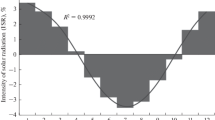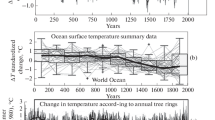Abstract
Numerical experiments have been carried out with a two-dimensional sector averaged global climate model in order to assess the potential impact of solar variability on the Earth's surface temperature from 1700 to 1992. This was done by investigating the model response to the variations in solar radiation caused by the changes in the Earth's orbital elements, as well as by the changes intrinsic to the Sun. In the absence of a full physical theory able to explain the origin of the observed total solar irradiance variations, three different total solar irradiance reconstructions have been used. A total solar irradiance change due to the photospheric effects incorporated in the Willson and Hudson (1988) parameterization, and the newly reconstructed solar total irradiance variations from the solar models of Hoyt and Schatten (1993) and Lean et al. (1995). Our results indicate that while the influence of the orbital forcing on the annual and global mean surface temperature is negligible at the century time scale, the monthly mean response to this forcing can be quite different from one month to another. The modelled global warming due to the three investigated total solar irradiance reconstructions is insufficient to reproduce the observed 20th century warming. Nevertheless, our simulated surface temperature response to the changes in the Sun's radiant energy output suggests that the Gleissberg cycle (≈88 years) solar forcing should not be neglected in explaining the century-scale climate variations. Finally, spectral analysis seems to point out that the 10- to 12-year oscillations found in the recorded Northern Hemisphere temperature variations from 1700 to 1992 could be unrelated to the solar forcing. Such a result could indicate that the eleven-year period which is frequently found in climate data might be related to oscillations in the atmosphere or oceans, internal to the climate system.
Similar content being viewed by others
References
Berger, A.: 1977, ‘Long-Term Variations of the Earth's Orbital Elements’, Celestial Mech. 15, 53–74.
Berger, A.: 1978, ‘Long-Term Variations of Daily Insolation and Quaternary Climatic Changes’, J. Atmos. Sci. 35, 2362–2367.
Berger, A.: 1988, ‘Milankovitch Theory and Climate’, Rev. Geophys. 26, 624–657.
Bertrand, C., van Ypersele, J.-P., and Berger, A: 1999, ‘Volcanic and Solar Impacts on Climate Since 1700’, Clim. Dyn. 15, 355–367.
Bradley, R. S. and Jones, P. D.: 1993, ‘“Little Ice Age” Summer Temperature Variations: Their Nature and Relevance to Recent Global Warming Trends’, Holocene 3, 367–376.
Crowley, T. J. and North, G. R.: 1991, Paleoclimatology, Oxford University Press, New York, p. 339.
Crowley, T. J. and Kim, K.-Y.: 1996, ‘Comparison of Proxy Records of Climate Change and Solar Forcing’, Geophys. Res. Lett. 23, 359–362.
Cubasch, U., Voss, R., Hegerl, G. C., Waszkewitz, J., and Crowley, T. J.: 1997, ‘Simulation of the Influence of Solar Radiation Variations on the Global Climate with an Ocean-Atmosphere General Circulation Model’, Clim. Dyn. 13, 757–767.
Dickinson, R.: 1975, ‘Solar Variability in the Lower Atmosphere’, Bull. Amer. Meteorol. Soc. 56, 1240–1248.
Dunkerton, T. J. and Baldwin, M. P.: 1992, ‘Modes of Interannual Variability in the Stratosphere’, Geophys. Res. Lett. 19, 49–52.
Eddy, J. A.: 1976, ‘The Maunder Minimum’, Science 192, 1189–1202.
Eddy, J. A.: 1988, ‘Variability of the Present and Ancient Sun: A Test of Solar Uniformitarianism’, in Stephenson, F. R. and Wolfendale, A. (eds.), Secular Solar and Geomagnetic Variations, Kluwer Academic Publishers, Dordrecht, pp. 1–23.
Eddy, J. A. and Oeschger, H.: 1993, ‘The Role of Solar Output Variations’, in Eddy, J. A. and Oeschger, H. (eds.), Global Changes in the Perspective of the Past, John Wiley and Sons Ltd, Chichester, pp. 279–294.
Fouquart, Y. and Bonnel, B.: 1980, ‘Computations of Solar Heating of the Earth's Atmosphere: A New Parameterization’, Beitr. Phys. Atmosph. 53, 35–62.
Friis-Christensen, E. and Lassen, K.: 1991, ‘Length of the Solar Cycle: An Indicator of Solar Activity Closely Associated with Climate’, Science 254, 698–700.
Gallée, H., van Ypersele, J.-P., Fichefet, Th., Tricot, Ch., and Berger, A.: 1991, ‘Simulation of the Last Glacial Cycle by a Coupled, Sectorially Averaged Climate-Ice Sheet Model 1. The Climate Model’, J. Geophys. Res. 96, 13,139–13,163.
Groveman, B. S. and Landsberg, H. E.: 1979, ‘Simulated Northern Hemisphere Temperature Departures 1579–1880’, Geophys. Res. Lett. 6, 767–769.
Haigh, J. D.: 1994, ‘The Role of Stratospheric Ozone in Modulating the Solar Radiative Forcing of Climate’, Nature 370, 544–546.
Haigh, J. D.: 1996, ‘The Impact of Solar Variability on Climate’, Science 272, 981–984.
Hickey, J. R., Alton, B. M., Kyle, H. L., and Hoyt, D. V.: 1988, ‘Total Solar Irradiance Measurements by ERB/Nimbus 7: A Review of Nine Years’, Space Sci. Rev. 48, 321–342.
Hoffert, M. I., Callegari, A. J., and Hsieh, C.-T.: 1980, ‘The Role of Deep Sea Heat Storage in the Secular Response to Climate Forcing’, J. Geophys. Res. 85, 6667–6679.
Hoffert, M. I., Frei, A., and Narayanan, V. K.: 1988, ‘Application of Solar Max ACRIM Data to Analysis of Solar-Driven Climatic Variability on Earth’, Clim. Change 13, 267–285.
Houghton, J. T., Meira Filho, L. G., Bruce, L., Hoesung Lee, Callander, B. A., Haites, E., Harris, N., and Maskell, K. (eds.): 1994, Climate Change 1994: Radiative Forcing of Climate Change and an Evaluation of the IPCC IS92 Emission Scenarios, Cambridge University Press, Cambridge, p. 339.
Houghton, J. T., Meira Filho, L. G., Callander, B. A., Harris, N., Kattenberg, A., and Maskell, K. (eds.): 1996, Climate Change 1995: The Science of Climate Change, Cambridge University Press, Cambridge, p. 572.
Hoyt, D. V. and Schatten, K. H.: 1993, ‘A Discussion of Plausible Solar Irradiance Variations, 1700–1992’, J. Geophys. Res. 98, 18,895–18,906.
Jones, P. D.: 1988, ‘The Influence of ENSO on Global Temperatures’, Climate Monitor 17(3), 80–89.
Jones, P. D. and Briffa, K. R.: 1992, ‘Global Surface Air Temperature Variations during the Twentieth Century: Part 1, Spatial, Temporal and Seasonal Details’, The Holocene 2, 165–179.
Kaufmann, R. K. and Stern, D. I.: 1997, ‘Evidence for Human Influence on Climate from Hemispheric Temperature Relations’, Nature 388, 39–44.
Kelly, P. M. and Wigley, T. M. L.: 1992, ‘Solar Cycle Length, Greenhouse Forcing and Global Climate’, Nature 360, 328–330.
Labitzke, K. and van Loon, H.: 1993, ‘Some Recent Studies of Probable Connections between Solar and Atmospheric Variability’, Ann. Geophys. 11, 1084–1094.
Labitzke, K. and van Loon, H.: 1995, ‘Connection Between the Troposphere and Stratosphere on a Decadal Scale’, Tellus 47A, 275–286.
Lean, J.: 1989, ‘Contribution of Ultraviolet Irradiance Variations to Changes in the Sun's Total Irradiance’, Science 244, 197–200.
Lean, J., Skumanich, A., and White, O.: 1992, ‘Estimating the Sun's Radiative Output during the Maunder Minimum’, Geophys. Res. Lett. 19, 1591–1594.
Lean, J., Beer, J., and Bradley, R.: 1995, ‘Reconstruction of Solar Irradiance Since 1600: Implications for Climate Change’, Geophys. Res. Lett. 22, 3195–3198.
Morcrette, J. J.: 1984, Sur la paramétrisation du rayonnement dans les modèles de la circulation générale atmosphérique, Thèse de Doctorat d'Etat, Univ. des Sci. et Tech. de Lille, Lille, France, p. 373.
Nesme-Ribes, E., Ferreira, E. N., Sadourny, R., Le Treut, H., and Li, Z. X.: 1993, ‘Solar Dynamics and its Impact on Solar Irradiance and Terrestrial Climate’, J. Geophys. Res. 98, 18923–18935.
Newman, M. J. and Rood, R. T.: 1977, ‘Implications of Solar Evolution for Earth's Early Atmosphere’, Science 198, 1035–1037.
Park, J., Lindberg, C. R., and Vernon, F. L. I.: 1987, ‘Multitaper Spectral Analysis of High-Frequency Seismograms’, J. Geophys. Res. 92, 12,675–12,684.
Reid, G. C.: 1991, ‘Solar Irradiance Variations and Global Sea Surface Temperature Record’, J. Geophys. Res. 96, 2835–2844.
Reid, G. C.: 1997, ‘Solar Forcing of Global Climate Change since the Mid-17th Century’, Clim. Change 37, 391–405.
Rind, D. and Overpeck, J.: 1993, ‘Hypothesized Causes of Decade-to-Century Scale Climate Variability: Climate Model Results’, Quat. Sci. Rev. 12, 357–374.
Schlesinger, M. E. and Ramankutty, N.: 1992, ‘Implications for Global Warming of Intercycle Solar Irradiance Variations’, Nature 360, 330–333.
Schneider, S. H.: 1972, ‘Cloudiness as a Global Climate Feedback Mechanism: The Effects on the Radiation Balance and Surface Temperature of Variations in Cloudiness’, J. Atmos. Sci. 29, 1413–1422.
Smits, I., Fichefet, Th., Tricot, Ch., and van Ypersele, J.-P.: 1993, ‘A Model Study of the Time Evolution of Climate at the Secular Time Scale’, Atmósfera 6, 255–272.
Svensmark, H. and Friis-Christensen, E.: 1997, ‘Variation of Cosmic Ray Flux and Global Cloud Coverage — a Missing Link in Solar-Climate Relationships’, J. Atmos. Solar-Terr. Phys. 59, 1125–1232.
Thomson, D. J.: 1982, ‘Spectrum Estimation and Harmonic Analysis’, IEEE Proc. 70, 1055–1096.
Thomson, D. J.: 1990, ‘Quadratic-Inverse Spectrum Estimates: Applications to Palaeoclimatology’, Phil. Trans. Roy. Soc. A332, 539–597.
van Dorland, R. and van Ulden, A.: 1998, ‘Natural and Anthropogenic Variations in the Radiative Balance’, in KNMI Symposium Report, Sun and Climate: The Influence of Variations in Solar Activity on the Earth's Climate, De Bilt, The Nederlands.
van Ulden, A. and van Dorland, R.: 1998, ‘Statistical Relations between Solar Activity Anthropogenic Greenhouse Effect and Global Temperatures from 1856 to 1997’, in KNMI Symposium Report, Sun and Climate: The Influence of Variations in Solar Activity on the Earth's Climate, De Bilt, The Nederlands.
Wigley, T. M. L. and Kelly, P. M.: 1990, ‘Holocene Climatic Change, 14C Wiggles and Variations in Solar Irradiance’, Phil. Trans. Roy. Soc. A330, 547–560.
Willson, R. C. and Hudson, H. S.: 1988, ‘Solar Luminosity Variations in Solar Cycle 21’, Nature 332, 810–812.
Willson, R. C. and Hudson, H. S.: 1991, ‘The Sun's Luminosity over a Complete Solar Cycle’, Nature 351, 42–44.
Zielinski, G. A.: 1995, ‘Stratospheric Loading and Optical Depth Estimates of Explosive Volcanism over the Last 2100 Years Derived from the Greenland Ice Sheet Project 2 Ice Core’, J. Geophys. Res. 100, 20,937–20,955.
Author information
Authors and Affiliations
Rights and permissions
About this article
Cite this article
Bertrand, C., van Ypersele, JP. Potential Role of Solar Variability as an Agent for Climate Change. Climatic Change 43, 387–411 (1999). https://doi.org/10.1023/A:1005470900774
Issue Date:
DOI: https://doi.org/10.1023/A:1005470900774




